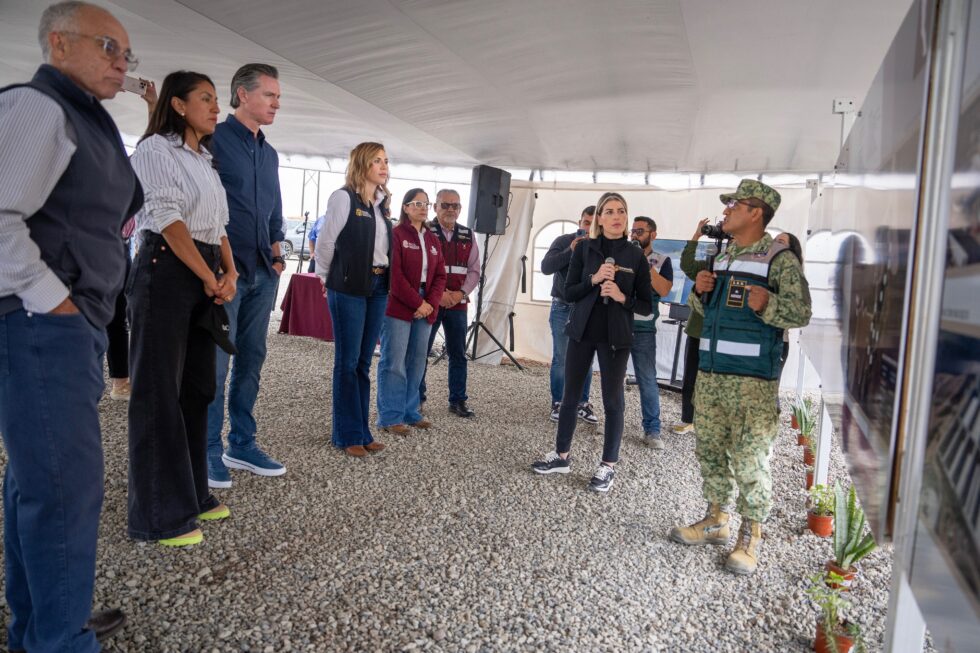
The most ambitious of the United States’ projects to tackle the Tijuana sewage crisis officially launched Oct. 29.
Rehabilitation and expansion of the South Bay International Wastewater Treatment Plant will double its capacity and, alongside other related projects, is expected to reduce the flow of untreated sewage into the Pacific Ocean by up to 90%.
At a ceremony hosted by the United States Section of the International Boundary and Water Commission (IBWC), leaders from both the U.S. and Mexico celebrated the milestone.
The plant is in need of large-scale rehabilitation, and the project will not only repair the plant’s myriad issues, but also, it will double its treatment capacity from 25 million gallons per day (MGD) to a 50 MGD average flow, with peak flow capacity at 75 MGD.
SBIWTP’s full rehabilitation and expansion is expected to take years, but it will be designed as it’s built, in effort to expedite the construction process.
It will take a maximum of five years, the IBWC says, but that timeline could be reduced by as many as 18 months by using a design-build method. The design phase is expected to take 20 months. The plant will remain in operation as construction is underway.
Work will start this year on setting up a bypass system for the plant’s primary facilities and structural assessments of the concrete structures.
In the meantime, the County of San Diego announced on Oct. 8 that it would distribute $2.7 million in air purifiers to local residents, an expense that will be reimbursed by the state.
The first phase, in the amount of $42.4 million, covers design for the full scope of the rehabilitation and expansion of SBIWTP. The USIBWC awarded the contract to PCL Construction of Long Beach, Calif. PCL selected Stantec Consulting Services, Inc., of San Diego, as the design firm.
The full project cost, including design, construction, contingencies, project management, and other support services, is estimated at $600 million.
“The USIBWC, our congressional supporters, the Department of State, the Environmental Protection Agency, and other federal, state, and local stakeholders, as well as the residents of this area, have been waiting for this moment for a long time,” said IBWC Commissioner Maria-Elena Giner, in a statement. “It’s taken a lot of work to get to this point, including more than $30 million in repairs to the plant over the last year. This expansion is just part of our strategy to help protect public health. We are also monitoring Mexico’s sanitation infrastructure improvements and taking urgent actions to eliminate dry weather transboundary flows.”

On Oct. 28, California Governor Gavin Newsom visited the plant alongside federal, state, and local leaders.
“The Tijuana River sewage crisis has impacted our communities for far too long,” Newsom said in a statement. “Thanks to our partnership with international, federal, and local partners, we are making real progress. But our work is far from over — we need serious, continued action to protect public health and restore our environment.”
Some advocates for the project have criticized Newsom for not declaring the millions of gallons of untreated wastewater that pour into the Pacific Ocean each day an emergency. But Newsom said that, since the matter is handled by the federally operated IBWC, declaring a state-level emergency was not applicable.
Proclaiming a state of emergency is a legal tool that allows governments to bypass certain requirements to resolve a matter quickly but, Newsom’s office argued at the time, the state cannot resolve the matter, so the legal mechanism is moot.
The Coronado City Council made a similar call earlier this year.
Newsom’s office has allocated $35 million in funding to support cleanup efforts in the Tijuana River Valley since 2019. This figure includes the $2.7 million in air purifiers for local residents announced earlier this month.
Mexico is also working on projects on its side of the border to improve wastewater infrastructure under Minute 328, an agreement between the US and Mexico outlining how each country will address the ongoing sewage problem. The latest update on Mexico’s projects is here.





Who can we contact to get an air purifier?
How & when will residents receive their new air purifiers?
Finally they r doing something for the sewage problems in Coronado.